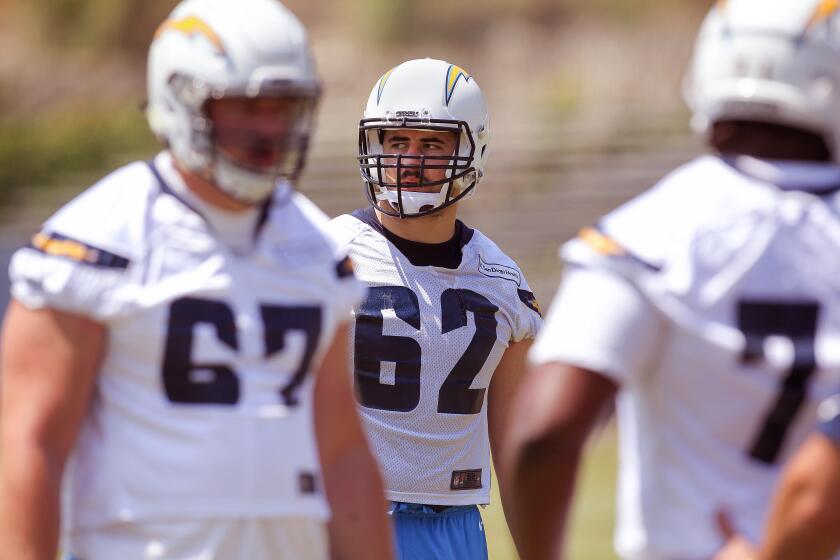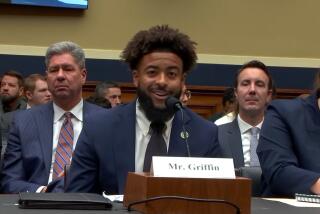Q&A: Here’s what jury must consider in USC’s Matt Gee landmark CTE lawsuit against the NCAA

Following a month of wildly disparate testimony, the landmark wrongful death suit brought by the widow of former USC linebacker Matthew Gee against the NCAA was sent to the jury Monday following closing arguments in Los Angeles Superior Court.
This is the first case in which a jury will decide whether hits to the head in college football led to chronic traumatic encephalopathy (CTE) and death. A 2018 case made it to trial but led to a settlement after several days of testimony by witnesses for the widow of Greg Ploetz, who played for Texas in the 1960s.
Alana Gee is seeking $54.8 million in damages for wrongful death and loss of her husband’s companionship based on her husband’s life expectancy.
Experts say the verdict will have implications beyond the potential award of damages. If the jury finds the NCAA responsible for Gee’s death, numerous similar lawsuits are expected to be brought against the governing body of college athletics.
If the jury finds that Gee’s death was not caused by CTE and the NCAA is not responsible, a precedent would be established that could hamper future lawsuits.
Closing arguments got testy when NCAA attorney Will Stute repeatedly interrupted the final rebuttal by Gee’s attorney William Horton with objections. Judge Terry Green overruled all but one objection.
When an exasperated Horton requested that Green tell Stute to cease the interruptions, Green replied that the jurors had been extraordinarily attentive and that he was confident they understood the evidence.
At the end of closing arguments, Green told the jury that in his several decades in courtrooms, he “can’t think of a better-tried case.’’ He congratulated the lawyers on both sides for “mastering a lot of material and presenting it in a way that was interesting” and understandable.
Here’s what the jury must consider as it begins deliberations Tuesday, which would have been Matt Gee’s 53rd birthday.
Who is Matt Gee?
Gee played linebacker for USC from 1989-1992 and led the team in tackles his junior and senior seasons. He was cut from training camp by the Oakland Raiders the following year after signing as an undrafted free agent and did not play in the NFL.
Gee and Alana met while both were college students, married and settled in Northridge. They had three children and Gee built a successful insurance business. They eventually moved to Simi Valley.
Gee is one of five linebackers from the 1989 USC team to die before age 50. The others are Junior Seau, Scott Ross, Alan Wilson and David Webb. Seau, a 12-time Pro Bowl selection with the San Diego Chargers, and Ross committed suicide. All displayed behavioral and mood symptoms associated with repetitive brain trauma and CTE. However, testimony about the death of Gee’s teammates was not allowed at the trial.
Former Hawaii quarterback Colt Brennan was found to have had Stage 1 chronic traumatic encephalopathy, his family was told this week.
How did Matt Gee die?
Gee died in his sleep at age 49 on Dec. 31, 2018. The coroner determined he died of sudden cardiac arrest and that acute alcohol and cocaine toxicity were contributing factors. Tests showed his blood alcohol level was four times the legal limit.
The defense introduced evidence that Gee had problems with alcohol dating back to middle school while growing up in Kansas and he began using cocaine at USC. Alana Gee testified she had no knowledge of her husband’s cocaine use and only became aware of his drinking a few years before his death.
The NCAA called experts that testified Gee’s health history and behavior made it impossible to attribute CTE as a cause of death. Gee’s attorneys sought to establish that CTE led to his accelerated alcohol and drug use in the final years of his life.
What health issues besides substance abuse could impact the verdict?
Gee had a long list of serious health problems throughout his life. Some were attributed to the effects of repetitive head trauma through the testimony of experts, while others were not.
Testimony established that Gee had severe, untreated hypertension since 1991. He also had coronary artery disease that led to the cardiac arrest, including documented ventricular arrhythmias. His heart was enlarged. He had advanced liver disease, untreated sleep apnea and was obese.
From birth, Gee suffered from Klippel-Trenaunay syndrome (KTS), a rare congenital malformation involving blood and lymph vessels and abnormal growth of soft and bone tissue. KTS is extremely painful and, according to testimony, Gee a few years before he died asked a doctor to cut off his left foot because he couldn’t stand the pain.
Testimony from Gee’s family and friends established that as his behavior deteriorated, he went from being a loving, stable husband, father and provider to someone given to impaired judgment, aggression, confusion and depression. The plaintiff’s experts testified that the symptoms were caused by CTE.
The defense countered by describing Gee’s hepatic encephalopathy, a nervous system disorder brought on by severe liver disease that elicits symptoms similar to those triggered by CTE.
“That’s what Mr. Gee had,” Stute said during closing arguments. “. . . shortened attention span, bizarre behavior, inappropriate behavior, muscular incoordination. ... Tremors, slurred speech, difficulty with concentration. ... The liver stops working and the brain is filled with confusion.”
Stute pointed to testimony from Alana Gee that her husband improved when he took medication for hepatic encephalopathy. “CTE is supposed to be an unrelenting degenerative condition. There is no getting better,” Stute said. “The fact that he got better is significant because it’s not consistent with CTE causing those symptoms.”
The trial was streamed on the Courtroom View Network.
Former USC and Chargers center Max Tuerk was suffering from CTE at the time of his death. His parents are trying to make sense of what happened to him.
What is the strongest evidence in Gee’s favor?
Gee’s attorneys called several prominent expert witnesses, including Dr. Robert Cantu, a neurosurgery specialist who is the medical director for the National Center for Sports Injury Research and co-director of the Center for the Study of Traumatic Encephalopathy at Boston University.
Cantu testified that Gee suffered from and eventually died from CTE and that playing college football was a substantial contributing factor in his death. Gee’s brain was examined by the UNITE Brain Bank at Boston University, which determined he suffered from Stage 2 CTE. Four progressive stages of CTE have been identified, with Stage 4 being the most severe.
“I believe a substantial contributing factor to his addiction was the CTE,” Cantu testified. “The CTE, I believe, was due to the trauma that his brain took while playing football, predominantly — not exclusively — but predominantly at the college level. I believe the CTE is what caused him to not be able to better manage his addiction.”
Cantu pointed out that the National Institute Neurological Disorders and Stroke (NINDS), part of the National Institutes of Health (NIH), in October formally acknowledged publicly for the first time that CTE is caused by repetitive traumatic brain injuries.
Evidence was presented that the NCAA might have deliberately destroyed documents that established the governing body knew more about the dangers of repetitive head injury and concussions to football players much earlier than stated. Stephen Casper, a professor and expert on traumatic brain injuries and concussions, testified that NCAA-produced journals from 1933 through 1966 are missing from the NCAA publications library, and that many of the journals include articles on what the NCAA had learned about the topic and recommended to curtail the damage.
The NCAA contends that it knew little about the the long-term effects of repetitive brain trauma other than the “punch-drunk” syndrome experienced by boxers.
What is the NCAA’s best evidence?
No evidence was presented to prove that Gee suffered a concussion at USC — or any other time. His parents testified that they don’t recall him having a concussion playing youth or high school football. They — and Alana Gee — testified that Matt never said he suffered a concussion while at USC. And before a tryout with the Raiders, Gee filled out a form that asked if he’d had a concussion. He checked “No.”
The only evidence that Gee suffered concussions was anecdotal. USC linebackers coach Tom Roggeman, who served as a Marine in Korea, was described as a taskmaster who relished hitting drills in practice. Former USC teammate Mike Salmon, brother of longtime Angels outfielder Tim Salmon, recalled Gee’s state of mind during practices and games.
“Matt hit like a truck,” Salmon testified. “I saw him quite a bit coming back to the huddle. You could tell ... he wasn’t all there.”
Stute attempted to distance the NCAA from responsibility for disseminating information about CTE and protocols pertaining to dealing with concussions by asserting that its member schools — not the governing body — were responsible. USC was not named as a defendant in Gee’s lawsuit.
Some NCAA witnesses, including former longtime UCLA team physician James Puffer, disputed that concussions lead to CTE. He testified that he doesn’t believe NCAA or even school officials must alert players to the risk of developing CTE.
“We don’t know with certainty at the present time that playing intercollegiate football irrefutably results in you developing CTE, or that playing intercollegiate football can lead to neurodegenerative disease,” Puffer told the jury.
A federal judge in Philadelphia approved new rules that seek to eliminate racial bias in the testing and payout of NFL concussion claims.
Could the verdict have broad implications for future CTE cases?
Scores of similar wrongful death and personal injury lawsuits have been brought by college football players against the NCAA in recent years, but this is only the second to make it to trial. A 2018 case in Texas settled before it would have gone to the jury.
An expert who requested anonymity said that if the NCAA wins, “it doesn’t mean the door is closed for future cases, but it does mean the bar is higher.”
Other cases could go forward, the expert said, especially those in which the deceased player doesn’t have the comorbidities of Matt Gee and those where the CTE is diagnosed as Stage 4 rather than Stage 2. “There are much more powerful cases out there,” the expert said.
If the jury finds in favor of Alana Gee, “I think there will be a settlement like the one with the NFL,” the expert said. “The implications would be significant.”
The NFL acknowledged in 2016 that research showed a link between football and head injuries. The league agreed to settle head-injury cases covering 20,000 retired players, providing up to $4 million for a death involving CTE. Payouts are expected to exceed $1.4 billion over 65 years for six qualifying conditions.
The NCAA settled a class-action concussion lawsuit in 2016 with little compensation going directly to individual players. The NCAA agreed to pay $70 million over 50 years to monitor former college athletes’ medical conditions and $5 million toward medical research with only payments of up to $5,000 toward individual players claiming injuries.
The medical monitoring program, according to documents filed in the case, “will make medical screening and Medical Evaluations available to all current and former NCAA student-athletes — regardless of when they played, what sport they played, for how long they played, in which state they played or reside, or their age.”
The settlement also includes return-to-play guidelines, academic accommodations for athletes who suffer concussions and concussion education and training for athletes, coaches and athletic trainers. One of these provisions mandates preseason baseline testing for every athlete at every NCAA school for each sport in which they participate.
Win or lose, the Gee case undoubtedly will be cited by lawyers in future litigation.
Must the jury determine beyond a reasonable doubt the NCAA is responsible?
No. This is a civil — not a criminal — proceeding, meaning the jury must apply the “preponderance of evidence” standard of proof. The jury must determine that Matt Gee’s death more likely than not was the result of CTE and that the NCAA is responsible.
Stute, the NCAA lawyer, made the point in his closing argument, breaking out an oft-used analogy in civil court to establish that the burden of proof is on the plaintiff.
“They have to push a boulder up the hill, and they have to start at zero, it’s not that we start at 50-50 and if they get one tink in their direction, they win,” Stute said. “They have to bring evidence. ... We don’t have to prove anything in this case, it’s not our burden. The plaintiff has to push that boulder up that hill a bit more than halfway to win.”
More to Read
Go beyond the scoreboard
Get the latest on L.A.'s teams in the daily Sports Report newsletter.
You may occasionally receive promotional content from the Los Angeles Times.










